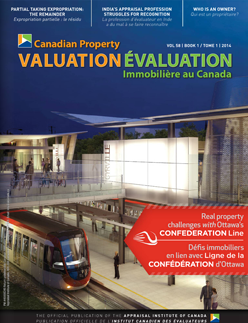Real property challenges with Ottawa’s largest infrastructure project in recent history
Canadian Property Valuation Magazine
Search the Library Online
By Gordon E. MacNair, AACI, P. App., SR/WA, is Director, Real Estate Partnerships & Development Office for the City of Ottawa and the Secretary and Chief Operating Officer for the Ottawa Community Land Development Corporation
In December 2012, Ottawa City Council awarded the contract to design, build, finance and maintain the first leg of Ottawa’s Light Rail Transit system – the Confederation Line – to the Rideau Transit Group (RTG).
The $2.13 billion Confederation Line is the largest infrastructure project in the City of Ottawa since the construction of the Rideau Canal. When complete and operational in 2018, the Confederation Line (shown on Diagram 1) will provide rapid and high-quality transit service from the Tunney’s Pasture Mixed Use Center/employment node in the west to Blair Station Mixed use Center/employment node in the east. This 12.5-kilometre, 13-station electric Light Rail Transit (LRT) system includes a 2.5-km tunnel to address the increasingly severe bus bottleneck through the downtown core that slows service and challenges the reliability of the City’s transit system.
The project is part of the City’s overarching and long-term smart-growth objectives laid out in the Official Plan, Transportation Master Plan, and Infrastructure Master Plan. Together, these plans call for the creation of densified, mixed-use neighbourhoods surrounding Confederation Line stations.
This article reviews the real property challenges associated with a project of this magnitude along with developing Transit Oriented Development (TOD) and other initiatives to support intensification.
Securing property for the Confederation Line
- The property requirements for the Confederation Line consist of four components:
- Confederation Line – guideway and stations
- Integrated Station Entrances and Business Development Strategy (BDS)
- Maintenance and Storage Facility (MSF)
- Easements for Hydro Ottawa
Confederation Line
The Confederation Line, except for the tunnel section, is a conversion of the City’s surface Bus Rapid Transit Network (BRT) and, therefore, exists mostly within the City’s right of way. A range of real estate acquisitions were required to permit the construction, future operation and maintenance of the Confederation Line, including the acquisition of fee simple interests, easements (permanent and temporary), licenses and encroachment permits. Many of these have been stratified to separate our surface, subsurface and aerial rights, as required to address complexities in property acquisition for tunnel construction through the downtown.
Public lands represent approximately 75% of the property requirements for the Confederation Line. The vast majority of these lands have been secured through complex Memorandums of Understanding (MOUs) with federal, provincial and other institutional landowners such as Parks Canada, Public Works and Government Services Canada, the Ontario Ministry of Transportation, the University of Ottawa and the National Capital Commission (NCC). Since a municipality does not have the power to expropriate federal or provincial land, detailed and multi-faceted processes were required to secure the right of way. While these complex negotiations presented many challenges, they also provided the City an opportunity to resolve outstanding property issues with the NCC dating back to the 1980’s relating to the construction of the bus rapid transitway.
Some of the property requirements for the Confederation Line were in private ownership. The majority of these property rights have been secured either through negotiated agreements or through the expropriation process. Where construction timing made it necessary for the City to initiate expropriation proceedings, the City has continued to pursue negotiated settlements with expropriated property owners. To date, the City has completed two rounds of expropriations and anticipates moving forward with a third round in 2014 to secure a number of temporary working easements should they be required.
From a valuation perspective, the acquisition of subterranean tunnel segments in the downtown core has presented a range of challenges. Compensation for these takings has yet to be settled in some instances; however, the City anticipates that factors such as the depth of the upper limit of the taking, the current use of the properties at grade, and betterment associated with the construction of the new transportation infrastructure will continue to play a central role in determining the market value of tunnel segments and injurious affection to remainder lands, if any. The Confederation Line tunnel is shown on Diagram 2.
Wherever possible, the City has attempted to minimize the need for property by making strategic use of existing City property for various project requirements such as staging areas and by entering into targeted agreements for limited property rights. For example, the City negotiated a five-year lease of a downtown surface parking lot that was being held for future development. The negotiated agreement provides access for tunneling equipment in the mid-section of the Confederation Line tunnel while leaving ownership of the parcel and the future development potential of the site with the property owner.
Integrated Station Entrances and Business Development Strategy
Maximizing station integration opportunities in the downtown core is a critical project element as it creates functional entrances, business connections and a more desirable commuting experience. It also frees up the City right of way on downtown streets creating a more functional public realm balancing the needs of transit users, pedestrians and cyclists while providing an opportunity for an improved streetscape. Therefore, it was an important property acquisition objective to secure the property rights for these integrated station entrances. An example of an integrated station is shown on Diagram 3.
Complementing this objective, and in recognition of the City’s goal to proactively engage private or public participants to promote ‘transit oriented developments’ (TOD) and connections at or near stations, the City undertook the Business Development Strategy initiatives in 2008. The first step of this process was to send out Requests for Information (RFI) to private sector businesses and landowners along the tunnel alignment. City staff also approached numerous landlords, developers, retailers, landowners and other interested parties to explore and promote opportunities to integrate into downtown stations. We have currently been successful in locating five of the six entrances for the three tunnel stations off the right of way. This strategy resulted in downtown properties connecting to the Confederation Line underground. Negotiating the property rights required for these entrances proved an interesting challenge in order to achieve a potential ‘win/win’ scenario for both parties. It was made particularly challenging insomuch as acquiring property rights within an existing building is somewhat unique and uncommon.
Term sheets have been executed with all five owners, with other documents, such as construction agreements, to follow at a later date. Three of these entrances will require integrating with or accommodation of existing structures such as office, mixed use and shopping centre buildings, while a fourth integrated station will require the demolition of an existing retail/office building entrance. A fifth downtown location is located on a vacant parcel of land, however, through the granting of air-rights, the station entrance planned for the site will be structurally designed to accommodate a large multi-storey building above it. The sixth entrance is located on City right of way.
Maintenance and Storage Facility (MSF)
The Maintenance and Storage Facility land assembly involved 18 improved properties with a total of 26 acres, approximately 340,000 sq. ft. of building space in office and industrial buildings, 12 owners and 19 tenants. The acquisition included the expropriation of a 10-unit industrial/commercial condominium in its entirety, which is believed to be the first expropriation of this kind in the Province of Ontario and possibly in Canada. The City registered the Expropriation Plan in January 2012, took possession in May 2012, and entered into occupancy agreements with most of the owners and tenants, with the last tenant vacating by March 2013.
After completing the expropriation of these properties, the City undertook a property management role with respect to the MSF properties for approximately a year and amended the occupancy agreements with some of the owners/tenants to provide sufficient time to relocate and, in some instances, construct a substitute property. From a compensation perspective, the relocation of expropriated owners/tenants presented some challenges for the City, as many replacement properties identified by the expropriated owners/tenants represented substantial betterments, including new construction and larger premises. Notwithstanding this, all of the expropriated owners/tenants have now secured replacement properties, and the City has financially settled with the majority of them.
The MSF facility will provide the maintenance and storage of vehicles for the Confederation Line LRT system, as shown on Diagram 4. Construction of the facility will be completed in time to allow it to be used to do the final assembly of the vehicles prior to commissioning. The project constructor, Rideau Transit Group (RTG), was handed possession of the MSF lands in April 2013, and all of the improvements have since been demolished.
The land assembly for the MSF also allowed the City to capitalize on a strategic acquisition for a property purchase (industrial building) to consolidate other City properties (OCTranspo) that are in close proximity to the MSF.
Easements for Hydro Ottawa
Throughout the design process for the Confederation Line, Hydro Ottawa identified easements required for its power infrastructure to service the LRT. Consequently, a Hydro Agency Agreement was executed between the City and Hydro Ottawa for the necessary approvals. In essence, the City acted as an agent for Hydro Ottawa with respect to the negotiated acquisition or, if necessary, the expropriation of the required property interests. Through negotiations, the City secured all of the necessary property requirements (easements) on behalf of Hydro Ottawa with 10 property owners, thus negating the need for expropriation. The City also coordinated and obtained temporary Licenses of Occupations for construction staging areas from adjacent public owners, necessary for the installation of Hydro Ottawa’s infrastructure.
Part of the success related to securing these property requirements for the Confederation Line was that City Council provided unlimited delegated authority to staff on all property acquisitions, subject to the concurrence of the local Ward Councilor. Settlements over $2M also required the concurrence of the Mayor, with the ability to report out only after all of the properties were acquired. This ensured that the property settlements remained confidential until all property had been secured.
Transit Oriented Development (TOD) and other initiatives supporting intensification
The Confederation Line will help achieve the City’s long-term growth objectives by acting as a catalyst for the development and redevelopment in the areas surrounding LRT stations. The City is already seeing an increased demand for development in these areas and the pace of this redevelopment is expected to increase leading up to the opening of the transit line and in the years after commissioning.
As a result of this demand, the City is proactively assessing areas around each station and creating Transit Oriented Development (TOD) plans. These studies are determined by an 800-metre radius around each station. All are based on smart growth principles and are designed to encourage complete, dense communities where people live, work, shop and play, while relying less on individual vehicle use. Emphasis is applied on planning designs that encourage alternative forms of transportation, including walking, cycling and public transit. Such planning initiatives will result in maximized returns on investment in major city-building infrastructure projects, like the Confederation Line. These also contribute to the overall economic, environmental, social and cultural sustainability of cities through efficient land use that accommodates growth on existing and planned infrastructure.
In that regard, the City has already completed Transit Oriented Development Plans and Community Development Plans (CDPs) for eight of the 13 stations, which includes the Tremblay, St. Laurent, Cyrville, Lees, Hurdman, Blair, Tunney’s Pasture, and Bayview stations.
With respect to intensification, like many municipalities, the City of Ottawa historically maintained a policy that discouraged development above major infrastructure. This policy was in accordance with best industry practice, as it ensured that operation of the infrastructure would not be compromised by development, and, conversely, development would not be compromised by infrastructure operation or failure. Further, it ensured that the degree of complexity associated with monitoring and maintaining the infrastructure would be kept to a minimum. The downside of this policy is that it constrained and sometimes precluded development in general and, often, in areas in which municipalities are looking to focus growth.
In recent years, improvements in infrastructure materials, construction techniques, and monitoring and maintenance practices along with the best-practice City-building smart growth goals of creating more compact, dense neighbourhoods close to major transit services has prompted a second look at policies related to building over top of municipal infrastructure. This is especially the case in situations where there are other benefits to promoting development in an area.
In order to encourage intensification, City Council has recently adopted a policy to ensure the City takes a uniform, risk-based approach when deciding what build-over rights above City infrastructure it will grant property owners. This decision will be made considering whether a proposal is appropriate for the area and is consistent with directions for the growth in the Official Plan, Secondary Plans, CDPs, Development/Design Guidelines, and the zoning bylaw. This policy now allows that, should it be deemed appropriate, the City will grant the property rights necessary to build over existing infrastructure in accordance with its disposal policy and procedures.
Summary
Securing the property requirements was an integral part of ensuring the success of this $2.13B infrastructure project and, in doing so, the City’s property team has faced significant challenges. However, through well-developed negotiation strategies, the required real estate assets were secured ‘on time’ and ‘within budget,’ without triggering any negative media coverage. Success was also achieved due to the establishment of fluid project management schedules.
The Confederation Line has already shown itself to be a catalyst for development and redevelopment in the areas surrounding LRT stations. The planning tools being developed, including TOD and the implementation of a uniform, risk-based approach for build-over rights above City infrastructure, will provide the appropriate intensification and smart growth. The Confederation Line is an important investment in the future of Ottawa. Smart planning tools, and excellent property acquisitions strategy help to maximize this investment.
Diagram 1
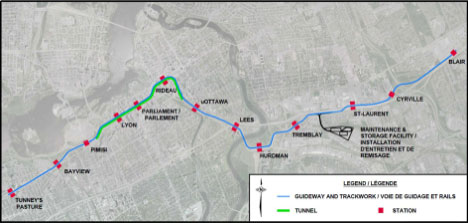
Diagram 2 (Confederation Line tunnel)
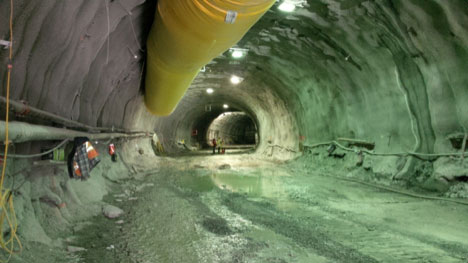
Diagram 3 (Integrated Station)
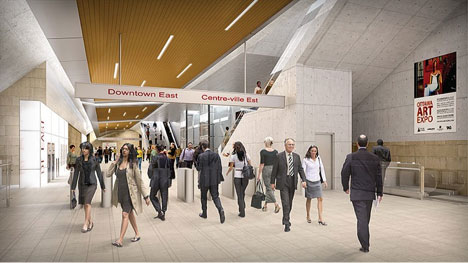
Diagram 4 (Maintenance & Storage Facility)
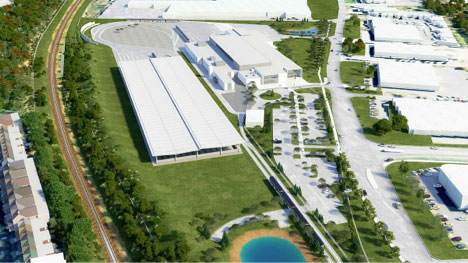
-30-





